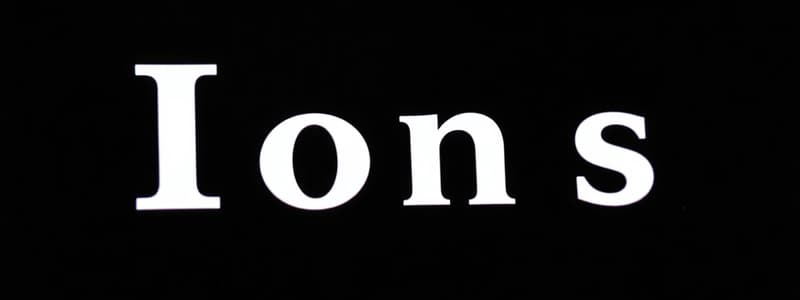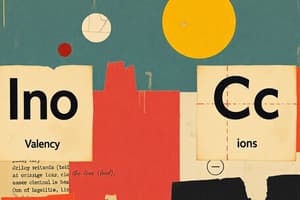Podcast
Questions and Answers
What is the term used for a positively charged atom or group of atoms?
What is the term used for a positively charged atom or group of atoms?
- Anion
- Electron
- Cation (correct)
- Ion
How many electron pairs are involved in a triple covalent bond?
How many electron pairs are involved in a triple covalent bond?
- Three (correct)
- Two
- One
- Four
What is the combining capacity of an element referred to as?
What is the combining capacity of an element referred to as?
- Molecule
- Valency (correct)
- Charge
- Mass number
Which type of bond is formed by the complete transfer of electrons from one atom to another?
Which type of bond is formed by the complete transfer of electrons from one atom to another?
What is the term for a symbolic representation of one molecule of an element or compound?
What is the term for a symbolic representation of one molecule of an element or compound?
What is the valency of chlorine when it forms hydrogen chloride (HCl)?
What is the valency of chlorine when it forms hydrogen chloride (HCl)?
How many hydrogen atoms are needed to form one molecule of water (H2O)?
How many hydrogen atoms are needed to form one molecule of water (H2O)?
What type of ion is formed when an atom loses electrons?
What type of ion is formed when an atom loses electrons?
Which ion has a valency of +2?
Which ion has a valency of +2?
What type of bond is formed by the complete transfer of an electron from one atom to another?
What type of bond is formed by the complete transfer of an electron from one atom to another?
Which type of bond is formed by the mutual sharing of two electron pairs between bonded atoms?
Which type of bond is formed by the mutual sharing of two electron pairs between bonded atoms?
Which of the following compounds is formed from the combination of sodium and sulfate ions?
Which of the following compounds is formed from the combination of sodium and sulfate ions?
Sodium chloride (NaCl) is formed through which type of bonding?
Sodium chloride (NaCl) is formed through which type of bonding?
What denotes a single covalent bond in molecular structures?
What denotes a single covalent bond in molecular structures?
If the valency of nitrogen is 3, how many hydrogen atoms are needed to form ammonia (NH3)?
If the valency of nitrogen is 3, how many hydrogen atoms are needed to form ammonia (NH3)?
In the formula for aluminium chloride (AlCl3), which element has a valency of 1?
In the formula for aluminium chloride (AlCl3), which element has a valency of 1?
Which of the following correctly describes the relationship between cations and anions?
Which of the following correctly describes the relationship between cations and anions?
What is the process of atoms combining to form chemical bonds primarily driven by?
What is the process of atoms combining to form chemical bonds primarily driven by?
How many electrons are shared in a triple covalent bond?
How many electrons are shared in a triple covalent bond?
Chlorine gains electrons to form which type of ion?
Chlorine gains electrons to form which type of ion?
Which of these compounds does NOT contain a double covalent bond?
Which of these compounds does NOT contain a double covalent bond?
Flashcards
Covalent Bond
Covalent Bond
A chemical bond formed by the sharing of electrons between atoms.
Triple Covalent Bond
Triple Covalent Bond
A covalent bond in which three electron pairs are shared between atoms.
Ionic Bond
Ionic Bond
A chemical bond formed by the complete transfer of electrons between atoms.
Ion
Ion
Signup and view all the flashcards
Valency
Valency
Signup and view all the flashcards
Valency of Chlorine
Valency of Chlorine
Signup and view all the flashcards
Valency of Oxygen
Valency of Oxygen
Signup and view all the flashcards
Sodium Sulphate Formula
Sodium Sulphate Formula
Signup and view all the flashcards
Aluminium Chloride Formula
Aluminium Chloride Formula
Signup and view all the flashcards
Chemical Bond
Chemical Bond
Signup and view all the flashcards
Atom Stability
Atom Stability
Signup and view all the flashcards
Writing Chemical Formulas (Ionic)
Writing Chemical Formulas (Ionic)
Signup and view all the flashcards
Single Covalent Bond
Single Covalent Bond
Signup and view all the flashcards
Double Covalent Bond
Double Covalent Bond
Signup and view all the flashcards
What is a covalent bond?
What is a covalent bond?
Signup and view all the flashcards
How are ions formed?
How are ions formed?
Signup and view all the flashcards
Study Notes
Ions
- An atom with a completely filled outermost electron shell is stable.
- Atoms with incomplete outer shells are unstable and can gain or lose electrons to become stable ions.
- Positively charged ions are called cations (lose electrons).
- Negatively charged ions are called anions (gain electrons).
Valency
- Atoms, except noble gases, have unstable electron configurations.
- They combine to gain stability, forming molecules/formula units.
- Valency is an atom's combining capacity.
- Valency is the number of hydrogen atoms that can combine or displace an atom of another element.
- Hydrogen's valency is 1.
- Valency of an element is shown in its chemical formula.
Chemical Formulas
- Chemical formulas represent the atoms in a molecule or formula unit.
- Symbols show the type of atoms.
- Subscripts show the number of each type of atom.
- Example: H₂O (two hydrogen atoms and one oxygen atom).
How to Write Chemical Formulas
- For ionic compounds, write the symbols of the positively and negatively charged ions side by side, then cross the valencies.
- If valencies are equal, they cancel out.
Chemical Bonds
- Atoms attain stability by having 2 or 8 electrons in their outermost shell (like noble gases).
- A chemical bond is the attractive force holding atoms together in a substance.
- Three types of bonds: ionic, covalent (single, double, triple).
- Ionic bonds: complete electron transfer between atoms, forming ions (oppositely charged).
- Covalent bonds: mutual electron sharing between atoms. Single bonds share one pair, double two pairs, and triple three pairs.
Studying That Suits You
Use AI to generate personalized quizzes and flashcards to suit your learning preferences.




